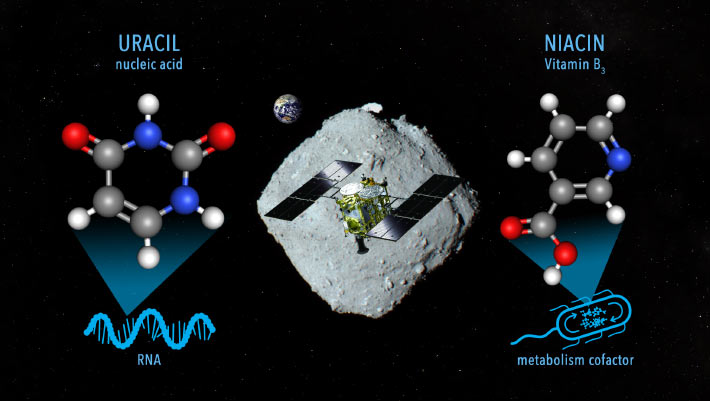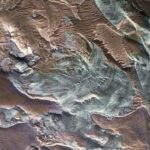An international team of researchers has detected nicotinic acid (also known as vitamin B3 or niacin) and uracil, one of the four nucleobases in ribonucleic acid, in aqueous extracts from samples of the C-type near-Earth asteroid (162173) Ryugu. The findings strongly suggest that such molecules of prebiotic interest commonly formed in carbonaceous asteroids including Ryugu and were delivered to the early Earth.
Oba et al. report the detection of uracil, one of the four nucleobases in ribonucleic acid, in aqueous extracts from Ryugu samples. Image credit: NASA’s Goddard Space Flight Center / JAXA / Dan Gallagher.
Ryugu was discovered in May 1999 by astronomers with the Lincoln Near-Earth Asteroid Research.
Also known as 1999 JU3, this asteroid measures approximately 900 m (0.56 miles) in diameter and orbits the Sun at a distance of 0.96-1.41 astronomical units once every 474 days.
JAXA’s Hayabusa-2, a sample-return mission to Ryugu, was launched on December 3, 2014 and arrived at the asteroid on June 27, 2018.
There, the spacecraft deployed rovers and landers onto Ryugu’s surface, and collected samples from near the surface.
On December 6, 2020, a total of 5.4 grams of pristine samples was returned to Earth in a hermetically sealed sample container within the re-entry capsule.
“Scientists have previously found nucleobases and vitamins in certain carbon-rich meteorites, but there was always the question of contamination by exposure to the Earth’s environment,” said Hokkaido University’s Dr. Yasuhiro Oba.
“Since Hayabusa-2 collected two samples directly from asteroid Ryugu and delivered them to Earth in sealed capsules, contamination can be ruled out.”
In the new research, Dr. Oba and colleagues searched for nucleobases and other classes of nitrogen molecules in the Ryugu samples.
They extracted these molecules by soaking the asteroid particles in hot water, followed by analyses using liquid chromatography coupled with high-resolution mass spectrometry.
The analysis revealed the presence of uracil and nicotinic acid, as well as other nitrogen-containing organic compounds.
“We found uracil in the samples in small amounts, in the range of 6-32 parts per billion (ppb), while vitamin B3 was more abundant, in the range of 49-99 ppb,” Dr. Oba said.
“Other biological molecules were found in the sample as well, including a selection of amino acids, amines and carboxylic acids, which are found in proteins and metabolism, respectively.”
The newly-detected compounds are similar but not identical to those previously discovered in carbon-rich meteorites.
“The difference in concentrations in the two samples, collected from different locations on Ryugu, is likely due to the exposure to the extreme environments of space,” the scientists said.
“The nitrogen-containing compounds were, at least in part, formed from the simpler molecules such as ammonia, formaldehyde and hydrogen cyanide.”
While these were not detected in the Ryugu samples, they are known to be present in cometary ice — and Ryugu could have originated as a comet or another parent body which had been present in low temperature environments.
“The discovery of uracil in the samples from Ryugu lends strength to current theories regarding the source of nucleobases in the early Earth,” Dr. Oba said.
“NASA’s OSIRIS-REx mission will return samples from asteroid Bennu this year, and a comparative study of the composition of these asteroids will provide further data to build on these theories.”
The results were published this week in the journal Nature Communications.
_____
Y. Oba et al. 2023. Uracil in the carbonaceous asteroid (162173) Ryugu. Nat Commun 14, 1292; doi: 10.1038/s41467-023-36904-3




